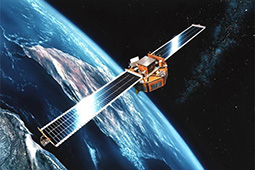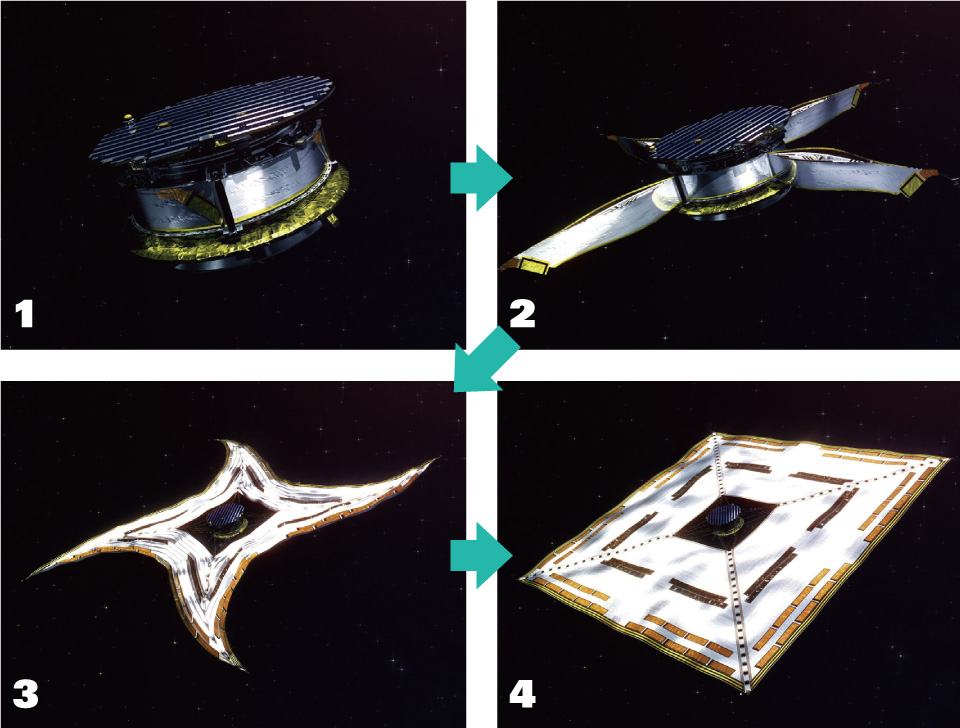INDEX
- English
- 日本語
- English
- 日本語

Illustration of the small solar power sail demonstration satellite IKAROS
Photo: Courtesy of JAXA

Space Flyer Unit (SFU), a satellite equipped with a planar structure made using the Miura fold
Photo: Courtesy of JAXA
Map using the Miura fold
Photo: Courtesy of Inoue General Print Co.,Ltd.
December 2021
Origami Techniques Applied to Space Development

Photo: Courtesy of JAXA
Origami techniques are being applied in Japan to space development and are expected to play a role in interplanetary navigation.

Photo: Courtesy of JAXA
Origami has developed as a popular pastime in Japan, but in recent years its techniques have been applied in many different fields. One of the best examples of this is the Miura-ori or Miura fold, devised in 1970 by Dr. Miura Koryo (currently Professor Emeritus at the University of Tokyo and President of the Japan Origami Academic Society). The Miura fold is a folding technique that allows even a large sheet of paper to be quickly opened out and stowed again by simply pushing and pulling on its diagonals. In Japan, this technique is usefully employed in products such as handy maps, tourist guides, and train route maps.

Photo: Courtesy of Inoue General Print Co.,Ltd.
The Miura fold was devised during research on deployable structures in space. The Space Flyer Unit (SFU), a satellite for space experiments and observations launched in 1995, used the Miura fold as a method of deploying and stowing a planar structure. The Miura fold allows the solar panels to be compactly stowed in the satellite’s confined space as well as to be easily deployed. Experiments have been successfully conducted in space on the deployment and stowage of solar panels for SFUs
In recent years, Japanese researchers have been experimenting further with the application of these origami techniques to space development. One such application is the space yacht, which is powered by sunlight rather than fuel. Just as a yacht on Earth is propelled by the wind in its sails, the space yacht is propelled by the pressure from photons* emitted from the sun (solar light pressure) on a large, square and thin membrane called a solar sail. The space yacht is a dream come true as it requires neither engine nor fuel, making it ideal for interplanetary exploration and navigation. To demonstrate this spacecraft technology, in May 2010 the Japan Aerospace Exploration Agency (JAXA) launched the world’s first small solar power sail demonstrator IKAROS which used origami techniques for the stowage and deployment of the solar sail.
IKAROS has a square sail approximately 14 meters long on each side and an ultra-thin membrane of 7.5 microns, around 13 times thinner than a human hair (measuring around 100 microns). It is propelled by solar pressure on its sail, and also generates electricity from a thin film of solar cells attached to part of the sail. During the launch, the large, thin solar sail is folded and stowed by wrapping around the cylindrical body. The satellite body is then rotated in space, with the centrifugal force generated by the rotation stretching the sail until it reaches full expansion. This is a proprietary technology developed by JAXA. After that, the main body continues to rotate to keep the sail fully expanded.
“The most challenging aspect of the IKAROS mission was the initial sail deployment. It was thrilling to see the 14-meter square solar sail beautifully unfurled, reflecting sunlight and shining in the jet-black space,” says Mori Osamu, Assistant Professor at JAXA’s Institute of Space and Astronautical Science and leader of the IKAROS project.
While developing the IKAROS sail, the project team tried out various folding methods for themselves using paper. Having been exposed to origami in Japan since their childhood, the idea of doing it this way came naturally to them. Rather than beginning with an idea imagined in their minds, the team used origami as a way of thinking with their hands. Later, they repeatedly experimented with the deployment of the sail using a massive piece of paper that was closer to the size of an actual solar sail in order to determine the optimal folding method. Having shared their envisaged ideas in advance, when it came to folding up the actual IKAROS sail the team members were able to work together with care and precision. Mori says that without this accumulation of experience and expertise inspired by the culture of origami, IKAROS would not have been successful.
“The technology we developed to fold the thin membrane of the sail compactly then unfurl it in space has the potential to dramatically change space development. In fact, I’ve heard that even NASA is directing its attention to the application of origami techniques,” says Mori proudly.
In the future, it is planned to apply the technology used successfully in IKAROS to thin-film solar panels for small satellites. Further, investigation is currently underway for the development of OKEANOS, a solar sail spacecraft even larger than IKAROS having a giant 40-meter square thin-membrane sail. The traditional Japanese technique of origami is expected to play a significant role in the future development of outer space.

1 After separating from the launch rocket, four weights attached to the corners of the square sail are released simultaneously.
2 The struts holding down the wrapped sail slide little by little, and the sail is gradually pulled out by centrifugal force. When fully extended, the sail forms a cross shape.
3 When the struts are flattened down, the folded sail is released and expands quickly due to centrifugal force.
4 The sail retains its expanded square shape by maintaining the rotation after deployment.
Photos: Courtesy of JAXA
* A photon is a quantum (the smallest amount of many forms of energy) of electromagnetic radiation.

